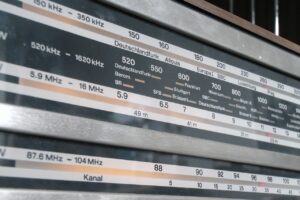by Paul Walker, Program Director, KSKO 89.5 McGrath Alaska (not my radio, stock photo)
Some have asked, so I thought I’d share. Everyones DX’ing goals and rules are different and that’s what makes the hobby interesting……these are mine. If I logged everything, I’d have multi gigabytes of audio on a weekly basis that I’d never ever finish sorting through. Alaska seems to be a great place for direct long path, off the back or over the pole reception of alot of signals!
I have a schedule site (Eibispace.de) that gives me the frequency, schedule, broadcaster, transmitter location, language and target area of the signal. I then quickly work out in my mind where I am in relation to that.
Like something beaming from Oman or the UAE to the Middle East, I may be off center from the main lobe, but it’s a long path trip for that signal. Something from Botswana to Northern/Western African, I am in near the direct center main lobe of the long path of that, as I recall looking up at one point. Or I could be getting something off the back from Galbeni or Santa Maria de Galleria.
I quickly work that out in my head and ten figure out if that’s actual DX. Then i quickly evaluate the signal.. quality over quantity. I know what many signals are capable of here at some point or another.. and If I’m getting a noisy, fadey signal where I know anything from alot better is possible to common, I won’t log it or record audio.
I do regularly log some poor to fair signals because they are rare here and usually low power. (Tarma 4775khz, Brazil 15190khz, et al)
I also take into account what others have logged and how well. I go after the lesser heard or those not heard as well by others. I live in a very unique location for DX and I want to use my time wisely by learning about what I hear, what I hear and going after whatever my personal definition is of the most worthy signals to log.
I typically do not log anything of which I am in the target area or spill over area of. Like Radio Romania International, China Radio international.. because thats just easy pickin’s for me…. with a few exceptions
This is not to say anyone who logs only target area or easy stuff is doing it wrong. We just go after different things and do things differently.
If I logged everything I heard, I’d have multi gigabytes of audio on a weekly basis that I’d never ever finish sorting through and as Thomas Witherspoon knows, I’m behind with processing my audio all the time as it is!


One of the best descriptions of LP and SP reception can be found on Basu, VU2NSB’s brilliant website.
https://vu2nsb.com/hf-long-path-lp/
As already mentioned, off the back of the beam is not necessarily LP reception and is a common misconception.
One of the best tools we used in the old days to work out the directions that SP and LP signals travelled was the “old-fashioned” globe of the world and a piece of string. 🙂 Nowadays, computer graphic calculations make the job easier.
Hi, Paul. I’m not exactly sure whether your definition of, “Long Path” is what the rest of us consider long path. To me, and other DXers, it’s the signal going the opposite way from the transmitter, usually across the South Pole and back to our listening site, as opposed to the signal continuing on it’s way past the destination of the transmitter and on to you. Off the back reception (Long Path) most certainly occurs, but is much less common than reception beyond the target destination. A common example of the latter is Madagascar beaming to W Africa and heard exceptionally well on the West Coast of North America (and likely Alaska). This is not long path.
That’s a great explanation of long path, Walt. I suspect you use “Simon’s World Map” as I do. It has a useful toggle for long path, to help you visualize the route your signal may take “the other way” around the globe.
https://www.dit-dit-dit.com/world-map
What logging software do you use for SWLing? I’m looking for something that can run on a server and accessible from anywhere, but so far haven’t found anything.
73 de M7WWX